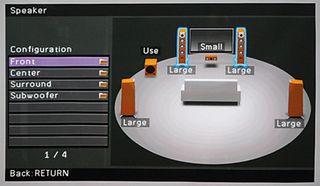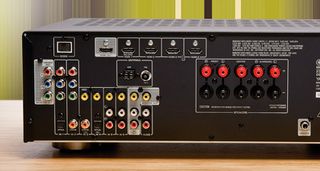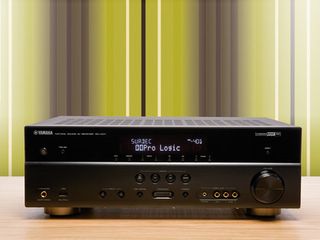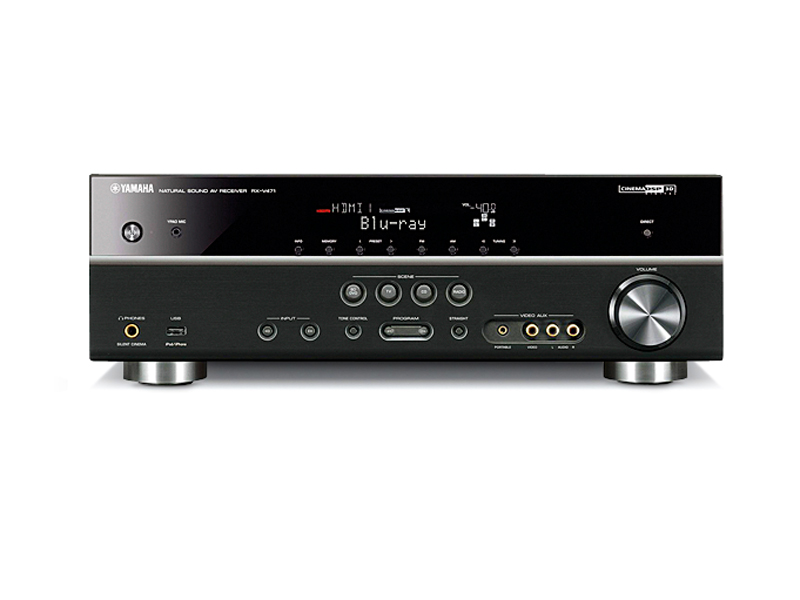TechRadar Verdict
Pros
- +
Class-leading sound
- +
Useful features
- +
Fabulously easy to use
Cons
- -
No networking or zone 2 output
- -
Little manual control of RoomEQ
Why you can trust TechRadar
There has been something of a dry spell for new AVRs of late. Months have passed without seeing one then, like buses, Yamaha launches the five-model strong RX-Vx71 lineup all at once. We got our hands on the baby brother the Yamaha RX-V471 AVR.
To celebrate the 25 years since the launch of its Cinema DSP technology, Yamaha's fledglings get some cutting edge features and obligatory eco-friendly credentials, too.
While the flagship RX-V771 looks stunning on paper, I suspect this was a ruse by Yamaha just to tease us, because the RX-V471 turns out to be an absolute corker.
First off, gone are the symmetrical cosmetics from the 1987-AVR Designer's Handbook. They have been replaced with a slick and thoroughly contemporary, part-gloss fascia. Having dissed the brand's AVR aesthetics in print for nearly a quarter of a century, this is a revelation to me.
And it is equally sleek around the back where there are just enough essential connections, such as 4-in 1-out v1.4 HDMIs, a selection of digital connections, component video and a Yamaha accessory port. There's no longer a dedicated dock for porting an iPod/iPhone, unless you want a wireless connection, for when both Wi-Fi and Bluetooth docks are available.
Instead all five models in the range extract raw digital audio, play lists and even display album artwork from a standard USB input.
In my opinion, this more than makes up for a lack of network connectivity, delivering high-quality music-server functionality for the price of an iPod. There is a Compressed Music Enhancer in the DSP modes, but my advice would be to buy your iPod big and go VBR or lossless for best sound quality.
Of course, at this price you only get five channels of amplification for Dolby and DTS 5.1 formats, at a claimed 100W a-piece (although our Tech Labs rate them lower).
Research pays off

It is also clear that more than a few months of research and development have been lavished on the user interface, too.
The RX-V471 boots up fast with a colourful high-definition image of a Yamaha piano on screen. A single press of the remote has the full-colour GUI overlay sliding up from the bottom of the screen offering a raft of easy-to-follow options.
Once the supplied set-up mic is installed (in the correct port and not, as I did, into the fascia-mounted 3.5mm input jack) the receiver automatically pulls up the auto set-up menus. Powered up, the receiver makes a few suitably eye-watering noises and announces all is well in under two minutes.
The YPAO room EQ system is a fairly basic incarnation of the technology and offers no manual adjustment beyond three presets. The GUI overlay enables you to play content and flick between each mode easily to select whichever you prefer.
Ironically, in a blind test, I ended up plumping for the 'EQ off' mode, but in a standard living room which has less than optimal speaker positioning I suspect the YPAO will come into its own.
The features list is not too shoddy for a £300 receiver and concentrates on those that will actually get used rather than specification trumps. There is no video upscaling, but you do get HDMI input switching in the frugal 1.2W standby mode for those days when you just want to watch and listen to the TV.
On fire

At all other times the RX-V471 delivers performance to set your socks on fire. Sounding agile, potent and incredibly detailed, this little receiver would give last year's £800 models a run for their money in pure performance.
Within seconds of spinning up Iron Man on Blu-ray I was hearing little details that older models at twice the price would gloss over.
As Stark emerges from the imprisoning cave, the LFE handling is sharp and visceral. This is no slow-burn performer that you might warm too; this is an immediate wow-factor machine that punches out a holographic surround soundstage with precision that I have not heard in any AVR the affordable side of £500.
I considered it may be the preceding dry-spell of amps that let the Yamaha gain my affections, so I garnered a second opinion. Mrs S has been exposed to a lot of AVRs over the years, so I played two scenes from different discs and asked her to guess the price of the Yamaha. She plumped for '£600-£800'. Okay, so it's not just me then.
The RX-V471's winning quality is undoubtedly its superb balance, which seems to let the dialogue, effects and action shine through. This pulls you into the movie, letting you forget about the electronics and speakers and simply enjoy the plot.
It is the result of a very clean sound through the mid-range; open, spacious and free from any congestion. Effects such as the spent bullet cases dropping to the floor have a wonderful metallic quality and the RX-V471 places each one with individual precision. Bass effects are robust and punchy without being overbearing and the top end deliver plenty of sparkle.
On one hand the sound is much firmer and fruitier than the competition, yet feed the AVR a diet of drama and it offers unrivalled clarity at this price, too.
The King's Speech is delivered with intensity and gravitas, underpinning the anguish of Colin Firth's King George with superb realism. I found myself holding my breath, willing the character to enunciate the next stammered word.
This rare combination of power and precision makes the RX-V471 something of an all-rounder, equally at home with family-friendly Disney fun as it is 18-cert action mayhem. To test the point, I slipped in the original Ice Age on Blu-ray and another thoroughly entertaining 90 minutes slipped by.
Even nudging the volume skyward results in a very pleasant surprise. While most budget receivers start to struggle and harden up when the volume gets much beyond –5dB, the Yamaha finds untapped reserves, simply powering into seriously 'neighbour-unfriendly' territory.
With 0dB showing on the clock, the sound retains its fine balance and clarity with the bass effects threatening to bring down the light fittings. Great fun? You bet.
The iPod/iPhone hook-up is simplicity itself, using no more than the Apple supplied USB lead. The RX-V471 quickly lists all the tracks and artists.
Once you hit Play, the GUI pulls up the cover art work from the device a few seconds later – all controlled by the Yamaha's simple remote. Further up the model range you get App control as well, but I guess at this price point you can't have everything.
Benchmarks

Power consumption: Watts
Idle: 41
Powered: 110
Power ratings: Watts (8 Ohms @ 0.5% THD)
2 channel 8 Ohms: 80
5 channel 8 Ohms: 60
Signal/Noise: dB
20 Hz: 85 dB
1 kHz: 85 dB
20 kHz: 85 dB
Style, substance, value

While more affluent receivers offer more power, greater resolution and additional features, I can't remember a time when a budget AVR impressed me so much.
It is stylish on the shelf, amazingly easy to use, offers a useful set of features and tops it all off with comfortably class-leading sound at the price.
Follow TechRadar Reviews on Twitter: http://twitter.com/techradarreview

